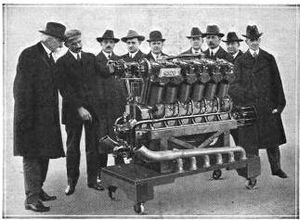Lincoln Motor Company Plant facts for kids
|
Lincoln Motor Company Plant
|
|

Lincoln plant in 1923, showing newer Ford-built addition in rear
|
|
| Location | 6200 W. Warren Ave., Detroit, Michigan |
|---|---|
| Area | 62 acres (25 ha) |
| Built | 1917 |
| Built by | Walbridge-Aldinger Co. |
| Architect | George Mason, Albert Kahn |
| NRHP reference No. | 78001521 |
Quick facts for kids Significant dates |
|
| Added to NRHP | June 2, 1978 |
| Designated NHL | June 2, 1978 |
| Delisted NHL | April 4, 2005 |
The Lincoln Motor Company Plant was a large factory in Detroit, Michigan. It was located at 6200 West Warren Avenue. This plant was very important in history. It helped build special engines for planes during World War I. Later, it became famous for making luxury cars for the Lincoln Motor Company.
In 1978, the plant was named a National Historic Landmark. This means it was a very important place in American history. However, most of the main buildings were torn down in 2003. Because of this, it lost its special landmark status in 2005.
Contents
Building Cars and Engines
Henry Leland's Vision

A man named Henry Leland was a skilled car maker. He helped make Cadillac a popular luxury car brand starting in 1902. He sold Cadillac to General Motors in 1908. But he kept working with them for many years.
In the mid-1910s, Leland left Cadillac. He wanted to help with the World War I effort. So, in 1917, he started the Lincoln Motor Company. His goal was to build powerful Liberty engines for fighter planes. These engines used parts from Ford Motor Company.
Leland bought some land in Detroit for his new factory. He hired George Mason to design the buildings. The company Walbridge-Aldinger built them. The factory complex grew to over 600,000 square feet (56,000 m2). It included many buildings. There was an Administration Building, a machine shop, and main factories. There was also a power house and a motor testing building.
By January 1919, the plant had made 6,500 Liberty engines. Soon after, the war ended. Lincoln thought about making car engines for other companies. But they decided to make luxury cars instead. However, there were delays in making the cars. Also, the economy was bad in 1920. This hurt sales, and the company faced financial trouble.
| Early images of the Lincoln Plant Interior
|
|---|
Ford Takes Over Lincoln
In 1922, Henry Ford bought the Lincoln Motor Company. He paid $8,000,000 for it. Ford wanted Lincoln to be the luxury car brand for his own company. Henry Leland stayed on to manage things at first. But Leland and Ford had different ideas. Leland left the company after only a few months.
Ford immediately started to improve the factory. He changed how things were made. He also made the complex much bigger. He hired architect Albert Kahn to design new buildings. These additions added over 300,000 square feet (28,000 m2) to the plant.
Famous Lincoln cars like the Zephyr and Continental were made here. Production continued at this factory until 1952. Then, the car making moved to a new plant in Wayne, Michigan. A brand new plant in Wixom opened in 1957.
What Happened to the Plant?
After car production moved, Ford still used some offices at the plant. They also rented out parts of the factory to other businesses. In 1955, Detroit Edison bought the entire complex. They paid $4,500,000 for it. Detroit Edison renamed it the Detroit Edison Warren Service Center. They used it for many of their services. Later, it was mainly used as a storage yard.
The Lincoln Motor Company Plant was very important. It was named a National Historic Landmark on June 2, 1978. But in December 2002 and January 2003, almost all the main buildings were torn down. Only a small part of one factory and some other small buildings remained. Because so much of the historic plant was gone, it lost its National Historic Landmark status on April 4, 2005.
| The Lincoln Plant Location 2010
|
|---|
See also
 In Spanish: Planta de Lincoln Motor Company para niños
In Spanish: Planta de Lincoln Motor Company para niños











